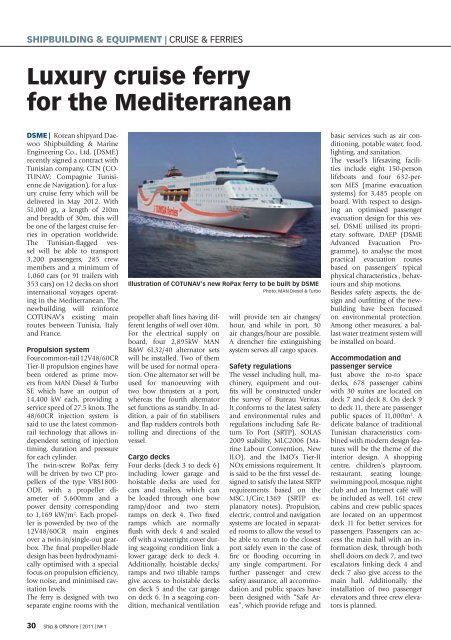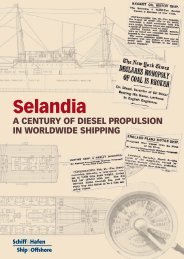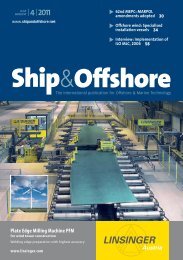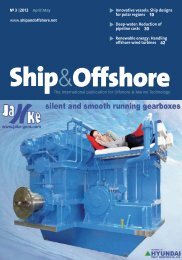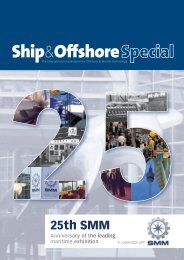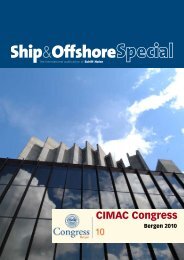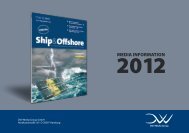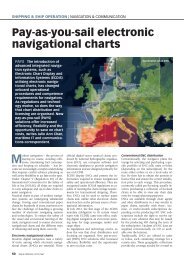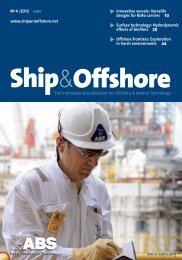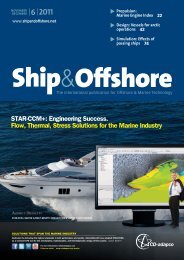Arctic technology: Winterisation of FPSO 38 Cruise ... - Ship & Offshore
Arctic technology: Winterisation of FPSO 38 Cruise ... - Ship & Offshore
Arctic technology: Winterisation of FPSO 38 Cruise ... - Ship & Offshore
Create successful ePaper yourself
Turn your PDF publications into a flip-book with our unique Google optimized e-Paper software.
SHIPBUILDING & EQUIPMENT | CRUISE & FERRIES<br />
Luxury cruise ferry<br />
for the Mediterranean<br />
DSME | Korean shipyard Daewoo<br />
<strong>Ship</strong>building & Marine<br />
Engineering Co., Ltd. (DSME)<br />
recently signed a contract with<br />
Tunisian company, CTN (CO-<br />
TUNAV; Compagnie Tunisienne<br />
de Navigation), for a luxury<br />
cruise ferry which will be<br />
delivered in May 2012. With<br />
51,000 gt, a length <strong>of</strong> 210m<br />
and breadth <strong>of</strong> 30m, this will<br />
be one <strong>of</strong> the largest cruise ferries<br />
in operation worldwide.<br />
The Tunisian-fl agged vessel<br />
will be able to transport<br />
3,200 passengers, 285 crew<br />
members and a minimum <strong>of</strong><br />
1,060 cars (or 91 trailers with<br />
353 cars) on 12 decks on short<br />
international voyages operating<br />
in the Mediterranean. The<br />
newbuilding will reinforce<br />
COTUNAV’s existing main<br />
routes between Tunisia, Italy<br />
and France.<br />
Propulsion system<br />
Four common-rail 12V48/60CR<br />
Tier-II propulsion engines have<br />
been ordered as prime movers<br />
from MAN Diesel & Turbo<br />
SE which have an output <strong>of</strong><br />
14,400 kW each, providing a<br />
service speed <strong>of</strong> 27.5 knots. The<br />
48/60CR injection system is<br />
said to use the latest commonrail<br />
<strong>technology</strong> that allows independent<br />
setting <strong>of</strong> injection<br />
timing, duration and pressure<br />
for each cylinder.<br />
The twin-screw RoPax ferry<br />
will be driven by two CP propellers<br />
<strong>of</strong> the type VBS1800-<br />
ODF, with a propeller diameter<br />
<strong>of</strong> 5,600mm and a<br />
power density corresponding<br />
to 1,169 kW/m 2 . Each propeller<br />
is pow erded by two <strong>of</strong> the<br />
12V48/60CR main engines<br />
over a twin-in/single-out gearbox.<br />
The fi nal propeller-blade<br />
design has been hydrodynamically<br />
optimised with a special<br />
focus on propulsion effi ciency,<br />
low noise, and minimised cavitation<br />
levels.<br />
The ferry is designed with two<br />
separate engine rooms with the<br />
30 <strong>Ship</strong> & <strong>Offshore</strong> | 2011 | N o 1<br />
Illustration <strong>of</strong> COTUNAV’s new RoPax ferry to be built by DSME<br />
Photo: MAN Diesel & Turbo<br />
propeller shaft lines having different<br />
lengths <strong>of</strong> well over 40m.<br />
For the electrical supply on<br />
board, four 2,895kW MAN<br />
B&W 6L32/40 alternator sets<br />
will be installed. Two <strong>of</strong> them<br />
will be used for normal operation.<br />
One alternator set will be<br />
used for manoeuvring with<br />
two bow thrusters at a port,<br />
whereas the fourth alternator<br />
set functions as standby. In addition,<br />
a pair <strong>of</strong> fi n stabilisers<br />
and fl ap rudders controls both<br />
rolling and directions <strong>of</strong> the<br />
vessel.<br />
Cargo decks<br />
Four decks (deck 3 to deck 6)<br />
including lower garage and<br />
hoistable decks are used for<br />
cars and trailers, which can<br />
be loaded through one bow<br />
ramp/door and two stern<br />
ramps on deck 4. Two fi xed<br />
ramps which are normally<br />
fl ush with deck 4 and sealed<br />
<strong>of</strong>f with a watertight cover during<br />
seagoing condition link a<br />
lower garage deck to deck 4.<br />
Additionally, hoistable decks/<br />
ramps and two tiltable ramps<br />
give access to hoistable decks<br />
on deck 5 and the car garage<br />
on deck 6. In a seagoing condition,<br />
mechanical ventilation<br />
will provide ten air changes/<br />
hour, and while in port, 30<br />
air changes/hour are possible.<br />
A drencher fi re extinguishing<br />
system serves all cargo spaces.<br />
Safety regulations<br />
The vessel including hull, machinery,<br />
equipment and outfi<br />
ts will be constructed under<br />
the survey <strong>of</strong> Bureau Veritas.<br />
It conforms to the latest safety<br />
and environmental rules and<br />
regulations including Safe Return<br />
To Port (SRTP), SOLAS<br />
2009 stability, MLC2006 (Marine<br />
Labour Convention, New<br />
ILO), and the IMO’s Tier-II<br />
NOx emissions requirement. It<br />
is said to be the fi rst vessel designed<br />
to satisfy the latest SRTP<br />
requirements based on the<br />
MSC.1/Circ.1369 (SRTP explanatory<br />
notes). Propulsion,<br />
electric, control and navigation<br />
systems are located in separated<br />
rooms to allow the vessel to<br />
be able to return to the closest<br />
port safely even in the case <strong>of</strong><br />
fi re or fl ooding occurring in<br />
any single compartment. For<br />
further passenger and crew<br />
safety assurance, all accommodation<br />
and public spaces have<br />
been designed with “Safe Areas”,<br />
which provide refuge and<br />
basic services such as air conditioning,<br />
potable water, food,<br />
lighting, and sanitation.<br />
The vessel’s lifesaving facilities<br />
include eight 150-person<br />
lifeboats and four 632-person<br />
MES (marine evacuation<br />
systems) for 3,485 people on<br />
board. With respect to designing<br />
an optimised passenger<br />
evacuation design for this vessel,<br />
DSME utilised its proprietary<br />
s<strong>of</strong>tware, DAEP (DSME<br />
Advanced Evacuation Programme),<br />
to analyse the most<br />
practical evacuation routes<br />
based on passengers’ typical<br />
physical characteristics , behaviours<br />
and ship motions.<br />
Besides safety aspects, the design<br />
and outfi tting <strong>of</strong> the newbuilding<br />
have been focused<br />
on environmental protection.<br />
Among other measures, a ballast<br />
water treatment system will<br />
be installed on board.<br />
Accommodation and<br />
passenger service<br />
Just above the ro-ro space<br />
decks, 678 passenger cabins<br />
with 30 suites are located on<br />
deck 7 and deck 8. On deck 9<br />
to deck 11, there are passenger<br />
public spaces <strong>of</strong> 11,000m 2 . A<br />
delicate balance <strong>of</strong> traditional<br />
Tunisian characteristics combined<br />
with modern design features<br />
will be the theme <strong>of</strong> the<br />
interior design. A shopping<br />
centre, children’s playroom,<br />
restaurant, seating lounge,<br />
swimming pool, mosque, night<br />
club and an Internet café will<br />
be included as well. 161 crew<br />
cabins and crew public spaces<br />
are located on an uppermost<br />
deck 11 for better services for<br />
passengers. Passengers can access<br />
the main hall with an information<br />
desk, through both<br />
shell doors on deck 7, and two<br />
escalators linking deck 4 and<br />
deck 7 also give access to the<br />
main hall. Additionally, the<br />
installation <strong>of</strong> two passenger<br />
elevators and three crew elevators<br />
is planned.


